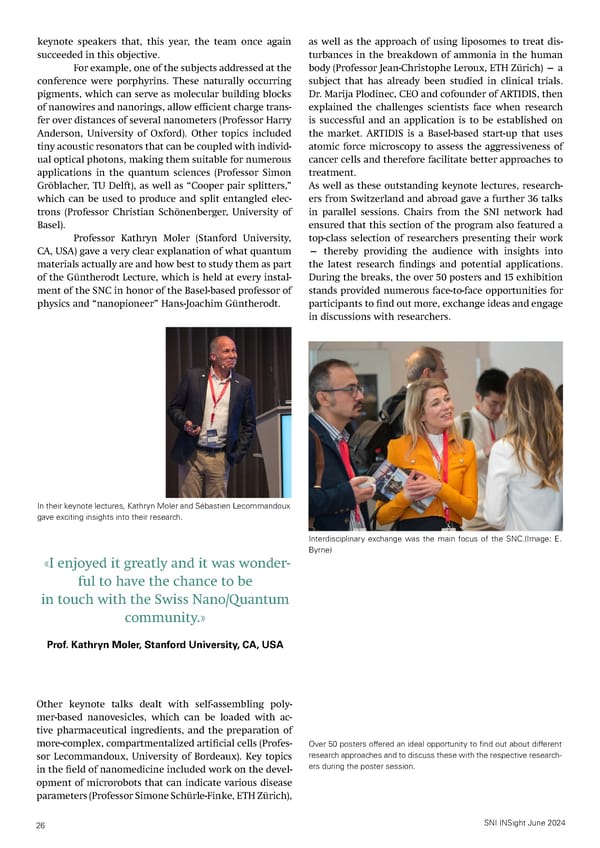keynote speakers that, this year, the team once again as well as the approach of using liposomes to treat dis- succeeded in this objective. turbances in the breakdown of ammonia in the human For example, one of the subjects addressed at the body (Professor Jean-Christophe Leroux, ETH Zürich) — a conference were porphyrins. These naturally occurring subject that has already been studied in clinical trials. pigments, which can serve as molecular building blocks Dr. Marija Plodinec, CEO and cofounder of ARTIDIS, then of nanowires and nanorings, allow e昀케cient charge trans- explained the challenges scientists face when research fer over distances of several nanometers (Professor Harry is successful and an application is to be established on Anderson, University of Oxford). Other topics included the market. ARTIDIS is a Basel-based start-up that uses tiny acoustic resonators that can be coupled with individ- atomic force microscopy to assess the aggressiveness of ual optical photons, making them suitable for numerous cancer cells and therefore facilitate better approaches to applications in the quantum sciences (Professor Simon treatment. Gröblacher, TU Delft), as well as “Cooper pair splitters,” As well as these outstanding keynote lectures, research- which can be used to produce and split entangled elec- ers from Switzerland and abroad gave a further 36 talks trons (Professor Christian Schönenberger, University of in parallel sessions. Chairs from the SNI network had Basel). ensured that this section of the program also featured a Professor Kathryn Moler (Stanford University, top-class selection of researchers presenting their work CA, USA) gave a very clear explanation of what quantum — thereby providing the audience with insights into materials actually are and how best to study them as part the latest research 昀椀ndings and potential applications. of the Güntherodt Lecture, which is held at every instal- During the breaks, the over 50 posters and 15 exhibition ment of the SNC in honor of the Basel-based professor of stands provided numerous face-to-face opportunities for physics and “nanopioneer” Hans-Joachim Güntherodt. participants to 昀椀nd out more, exchange ideas and engage in discussions with researchers. In their keynote lectures, Kathryn Moler and Sébastien Lecommandoux gave exciting insights into their research. Interdisciplinary exchange was the main focus of the SNC.(Image: E. Byrne) «I enjoyed it greatly and it was wonder- ful to have the chance to be in touch with the Swiss Nano/Quantum community.» Prof. Kathryn Moler, Stanford University, CA, USA Other keynote talks dealt with self-assembling poly- mer-based nanovesicles, which can be loaded with ac- tive pharmaceutical ingredients, and the preparation of more-complex, compartmentalized arti昀椀cial cells (Profes- Over 50 posters offered an ideal opportunity to 昀椀nd out about different sor Lecommandoux, University of Bordeaux). Key topics research approaches and to discuss these with the respective research- in the 昀椀eld of nanomedicine included work on the devel- ers during the poster session. opment of microrobots that can indicate various disease parameters (Professor Simone Schürle-Finke, ETH Zürich), SNI INSight June 2024 26
 SNI INSight June 2024 Page 25 Page 27
SNI INSight June 2024 Page 25 Page 27